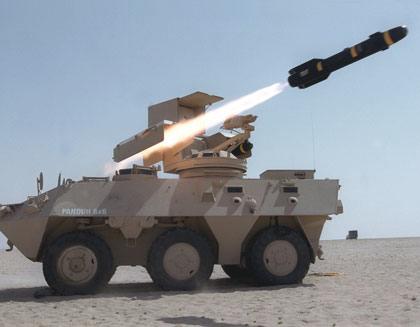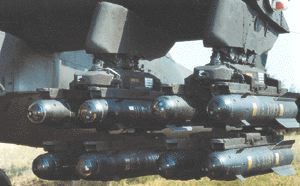Boeing/Lockheed Martin (Rockwell/Martin Marietta) AGM-114 Hellfire
The AGM-114 Hellfire is a fire-and-forget anti-armour missile mainly for use by helicopters. It is widely used by the U.S. Army, Navy, and Marine Corps.
The program to develop a laser guided fire-and-forget anti-armour missile was initiated in 1971 under the name Helicopter Launched Fire and Forget Missile (leading to the acronym Hellfire). Development and testing of laser designator and seeker components continued through 1976. In October that year, Rockwell was awarded a development contract for the newly designated AGM-114A Hellfire missile. Because Martin Marietta offered a cheaper seeker for Hellfire than Rockwell, the former eventually became an equal partner in the Hellfire prime contract. Test firings of YAGM-114A prototype missiles began in late 1978, and operational testing by the U.S. Army was completed in 1981. Full production was approved in 1982, and Initial Operational Capability of the AGM-114A with the U.S. Army was reached in 1985.
The AGM-114A missile was originally deployed by AH-64A helicopters on two-rail and four-rail launchers. It is powered by a Thiokol solid-propellant rocket motor, and uses four wide-chord fins with movable trailing-edge control surfaces for stability and control. The laser seeker of the Hellfire can lock on a designated target before or after launch. For almost simultaneous attack on multiple targets, the missile can be fired both in ripples (when all the targets are illuminated by different lasers) or in rapid succession (when one designator switches to the next target when one is hit). The AGM-114A has a maximum range of about 8000 m (8750 yd) and minimum effective range is reported to be around 1500 m (1640 yd). Its 8 kg (18 lb) shaped-charge anti-armour warhead is triggered by an impact fuze. Training variants of the AGM-114 are the Training Guided Missile M36 for captive-carry training ("CATM-114") and the Dummy Guided Missile M34 for ground handling training ("DATM-114").
 |
| Photo: via Jane's |
| AGM-114A |
The AGM-114B was the initial version of the U.S. Navy and Marine Corps (for its AH-1 helicopters), which was the same as the AGM-114A except for an SAD (Safing/Arming Device) for safe shipboard use. The AGM-114B also introduced the Thiokol TX-657 (M120E1) reduced-smoke rocket motor as well as some improvements to seeker and autopilot. A training version without warhead is designated ATM-114B. The AGM-114C was the Army's version of the AGM-114B without the SAD.
The Army's AGM-114D was to be an improved AGM-114C with a new digital autopilot, and the AGM-114E was the equivalent Navy/USMC version with the SAD. However, the AGM-114D/E was not developed.
The AGM-114F, also known as "Interim Hellfire", is a U.S. Army version with a new dual warhead to defeat reactive armour. The small precursor warhead is inserted between the laser seeker section and the main warhead, thereby slightly increasing the length of the missile. The AGM-114F also had a guidance section with improved clutter rejection, and a slightly reduced range. It entered production in 1991. The designation AGM-114G was reserved for a SAD-equipped Navy/USMC version of the AGM-114F, but this was not built. The AGM-114H was a derivative of the AGM-114F which replaced the latter's analog autopilot with a new reprogrammable digital system. However, the AGM-114H was apparently not produced.
In 1989 the development of a significantly improved Hellfire missile began. It was then known as HOMS (Hellfire Optimized Missile System) but is now called Hellfire II. Further improvements were incorporated into Hellfire II from 1991 as a result of some shortcomings of the basic Hellfire, which had been identified during Operation Desert Storm. Hellfire II features a completely new digital autopilot, a bigger precursor warhead, an improved seeker better suited to signal loss and countermeasures, and reprogrammable software. The last feature can be used to dynamically select different attack profiles (e.g. top or side attack) and precursor/main warhead detonation timing, to optimize the efficiency of the missile against different types of targets. Although the Hellfire II uses a tandem warhead like the AGM-114F, the improved systems allowed the use of the original shorter airframe of the AGM-114A/B/C. Because of its lighter components, maximum range is somewhat larger than that of the AGM-114F. It was originally intended to build two versions of Hellfire II, the AGM-114J for the Army and the AGM-114K with a new electronic SAD for the Navy/USMC. The AGM-114J was not produced, however, and all services adopted the AGM-114K. The first production AGM-114Ks were delivered in December 1994. Unarmed training variants of the AGM-114K are the ATM-114K for firing training and the non-firing CATM-114K. Boeing also developed a derative of the AGM-114K with a blast-fragmentation warhead (also used in the Swedish RBS-17 derivative) for anti-ship use. This variant, sometimes unofficially designated AGM-114KBF (-114K, Blast-Fragmentation), was intended for export.
 |
| Photo: Lockheed Martin |
| AGM-114K |
In 1992 the U.S. Army decided to develop a derivative of the AGM-114K with a new mm-wave (MMW) active radar seeker for use with the AN/APG-78 Longbow radar of the AH-64D. This new missile is known as "Longbow Hellfire" and designated AGM-114L. For short-range or moving targets, the AGM-114L's MMW seeker is locked on the target before launch using data from either the AN/APG-78 or the AH-64D's TADS (Target Acquisition & Designation Sight). For long-range shots at static targets, the missile is launched in the direction of the target and controlled by its inertial system until the MMW seeker locks on for terminal guidance. Firing tests of the AGM-114L began in 1994, production was authorized in 1995, and the first missiles entered service in 1998.
 |
| Photo: DOD |
| AGM-114 (exact model unknown) |
The AGM-114M is a derivative of the AGM-114K with a new blast-fragmentation warhead and a modified SAD. It is intended for use by U.S. Navy's MH-60R helicopters against semi-hardened and soft targets. The first AGM-114Ms were delivered to the Navy in December 2000. The AGM-114N is another AGM-114K derivative, and is equipped with a thermobaric warhead with a high initial blast overpresure followed by a relatively slow burn. The AGM-114K, -114M and -114N versions were all used operationally on AH-1W helicopters of the U.S. Marine Corps during Operation Iraqi Freedom in March/April 2003. The AGM-114P is an AGM-114K variant, which is optimized for employment from UAVs flying at high-altitude, while the ATM-114Q is another training variant of the Hellfire missile.
A significantly improved version of the AGM-114 missile was developed for the Army as the AGM-114R. This variant has a new Integrated Blast Frag Sleeve (IBFS) multi-purpose warhead, which combines the features of a shaped-charge and a blast-fragmentation warhead. Compared to the AGM-114P, the AGM-114R has increased engagement envelope and lethality, and a variable-delay fuze timed by laser codes. It can be employed by all Hellfire-compatible helicopter and UAV platforms.
The ATM-114S is a modified ATM-114Q with a spotting charge instead of a warhead, while the AGM-114T is a variant of the AGM-114R with an IM (Insensitive Muntion) rocket motor and electromagnetic control actuators. A special-purpose version of the Hellfire is known by the semi-official designation AGM-114R-9X, or simply "R9X". This missile replaces the explosive warhead with about 45 kg (100 lb) of dense material and six razor-sharp steel blades, which pop out immediately before impact. This is meant for precision strikes against individual persons with minimal collateral damage. The R9X has reportedly been used operationally several times in killings of high-ranking islamist terrorists.
Although the Hellfire is still mainly used in its original helicopter-borne application (the main current platforms being the AH-1W and AH-64), other launch options are possible. The U.S. Army has developed a launcher for ground vehicles, which can be used e.g. with the HMMWV (High Mobility Multipurpose Wheeled Vehicle). The Hellfire is also the primary air-to-ground weapon of several armed UAVs, including the USAF's MQ-1L Predator and MQ-9 Reaper and the Army's MQ-1C Gray Eagle. In the early 1990s, the Hellfire missile was even evaluated for use against low-speed aerial targets (i.e. helicopters) in both surface-to-air and air-to-air applications. However, these studies did not result in operational anti-helicopter Hellfire missiles.
From 2014 onwards, the U.S. Navy evaluated the use of a ship-based version of the AGM-114L from launchers on its Littoral Combat Ship (LCS) vessels. The Hellfire system for LCS is known as SSMM (Surface-to-Surface Missile Modules), and can hold 24 RGM-114L missiles in vertical launchers. After successful test firings in 2017, the system was first deployed on USS Detroit (LCS-7) in late 2019.
More than 100000 AGM-114 missiles of all variants had been built by 2020, and production is continuing with the AGM-114R/T versions. Current prime contractor for all variants except AGM-114L is Hellfire Systems LLC, a joint venture of Boeing and Lockheed Martin, while the AGM-114L prime contractor is Longbow LLC, a Lockheed Martin/Northrop Grumman joint venture. The Hellfire has also been exported to many foreign countries. Foreign derivatives of Hellfire include the Swedish RBS-17, a shore-based coast-defense derivative of the AGM-114A with a blast-fragmentation warhead, and the British Brimstone, an anti-armour variant with a MMW seeker of higher performance than that of the AGM-114L. The Lockheed Martin AGM-179 JAGM is also a direct development of the AGM-114R Hellfire.
Specifications
Note: Data given by several sources show slight variations. Figures given below may therefore be inaccurate!
Data for AGM-114B/C/F/K/L/R:
| AGM-114B/C | AGM-114F | AGM-114K | AGM-114L | AGM-114R | |
|---|---|---|---|---|---|
| Length | 1.63 m (64 in) | 1.80 m (71 in) | 1.63 m (64 in) | 1.78 m (70 in) | 1.63 m (64 in) |
| Wingspan | 33 cm (13 in) | ||||
| Diameter | 17.8 cm (7 in) | ||||
| Weight | 45.7 kg (100 lb) | 48.6 (107 lb) | 45.7 kg (100 lb) | 50 kg (110 lb) | 49.4 kg (109 lb) |
| Speed | Mach 1.3 | ||||
| Range | 8000 m (8750 yd) | 7000 m (7650 yd) | 9000 m (9850 yd) | 8000 m (8750 yd) | |
| Propulsion | Thiokol M120E1 solid-fuel rocket | ||||
| Warhead | 8 kg (18 lb) shaped-charge | 9 kg (20 lb) tandem anti-armour | Multi-purpose | ||
Main Sources
[1] Norman Friedman: "World Naval Weapons Systems, 1997/98", Naval Institute Press, 1997
[2] Christopher Chant: "World Encyclopaedia of Modern Air Weapons", Patrick Stephens Ltd., 1988
[3] Hajime Ozu: "Missile 2000 - Reference Guide to World Missile Systems", Shinkigensha, 2000
[4] Bernard Blake (ed.): "Jane's Weapon Systems 1987-88", Jane's, 1988
[5] Jane's Website:
"AGM-114 Hellfire", Jane's, 2000
[6] Redstone Arsenal Historical Information Website
[7] Robert Wall: "Cobras in Urban Combat", article in Aviation Week & Space Technology, 14 April 2003
[8] Various web resources, referenced by Wikipedia: AGM-114 Hellfire
Back to Current Designations Of U.S. Unmanned Military Aerospace Vehicles
Back to Directory of U.S. Military Rockets and Missiles
Last Updated: 17 December 2024